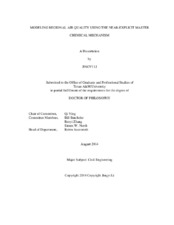| dc.description.abstract | In this study, the Master Chemical Mechanism (MCM), a near-explicit photochemical mechanism, is, for the first time, implemented into the Community Air Quality Model (CMAQ) model (referred to as CMAQ-MCM hereafter), a 3D chemical transport model, to study the spatial and temporal distribution of gaseous and particulate pollutants, and their chemical/physical properties in the eastern U.S.
First, CMAQ-MCM with only gas phase chemistry (MCMv3.1) was applied to study primary VOCs in Southeast Texas during a three-week high ozone episode in 2000. The model could reproduce temporal profiles of observed ozone concentrations at major observation stations. However, predicted concentrations of alkanes and alkenes in Southeast Texas are lower than the observation by a factor of 2-5. Missing fugitive and evaporative industrial emissions were determined to be the major cause of the under-prediction.
Second, the CMAQ-MCM was updated (to use MCMv3.2) and further developed to link with the inorganic aerosol module in CMAQ to study impacts of stabilized criegee intermediates (SCIs) on sulfate formation in the eastern U.S. Faster reaction rate of SCI with SO2, updated based on a recent experimental measurement (increased from 7×10^(-14) cm^(3) s^(-1) to 3.9×10^(-11) cm^(3) s^(-1)), leads to ~18% increase in surface sulfate concentration. However, the importance of this reaction greatly depends on the competition reaction rate of SCI with water vapor.
Moreover, an organic aerosol module that predicts secondary organic aerosol (SOA) formation from equilibrium partitioning of semi-volatile organic compounds (SVOCs) into the organic phase and from reactive uptake of glyoxal, methylglyoxal, and isoprene epoxydiols, was incorporated into the model (termed CMAQ-MCM-SOA) to study SOA formation in this region. The episode averaged total SOA concentration is 2-12 μg m^(-3), with the highest concentration occurring in the southeastern U.S. Isoprene epoxydiols are the major SOA component if an acidity dependent reactive uptake coefficient is used.
Finally, the isoprene mechanism in the MCM was updated to successfully reproduce experimental observed isoprene SOA yield and mass concentrations, and then applied to the regional CMAQ-MCM-SOA model. While total isoprene SOA concentrations were not changed significantly from the base case, more contributions from semi-volatile components and less from surface uptake were predicted. | en |


